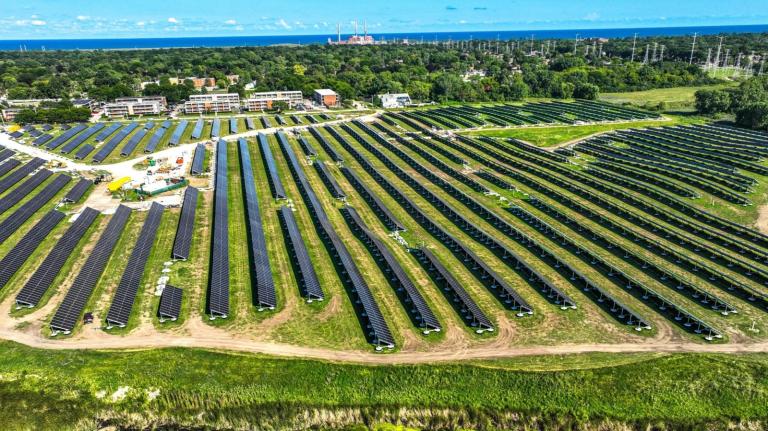As a method of processing biomass into liquid fuel, methanol tends to be less discussed than its more glamorous cousin ethanol. But it is much more efficient, and can accept just about any biological input besides.
Conventional pyrolysis can convert biomass to methanol with around a 50% efficiency — sometimes better [1]. (You can gain another 5%-8% in the form of electricity generated from waste steam.) Methanol can substitute for gasoline; it’s about half as dense, and costs around the same, so it runs double gasoline’s cost per BTU. Transport tankers and gas station storage tanks have to install special liners and new valves to handle it; cars also need modification for their engines to survive its corrosive nature.
There are also environmental, health and safety concerns, all of which can be addressed. Methanol is toxic and dangerous, like gasoline. Unlike both MTBE and gasoline, it is a naturally occurring substance that many organisms have evolved to predate on. If an underground methanol tank leaks, it will seep into the water table, where it will be diluted and broken down into less dangerous forms quickly [2] — nothing like the full year that is the minimum for MTBE. In the case of surface spills, the same thing will happen even faster. That doesn’t make spills trivial; like gasoline, we want to keep the stuff out of the environment and especially out of our water supplies.
If really heavy concentrations occur, then (again like gasoline) it can be cleaned up, though via different methods (high temperature steam oxidation, bioremediation, or both). In terms of fire safety, pure methanol is indeed more dangerous to store due to differences in vapors, colorlessness, and tastelessness. However, in practice, the maximum concentration usually advocated is 85% methanol and 15% gasoline. This takes care of all those problems; so long as transport and storage have been modified to resist corrosion by methanol, the fire safety is equivalent to gasoline [3].
Note that while methanol can run in modified gasoline engines [4], it has not been successful with diesel. While diesel engines can be modified to use methanol with efficiencies approaching or exceeding the best conventional diesels [5], maintenance and engine life to date have proven miserable compared to real diesel or biodiesel [6]. There is some work being done on making gasoline engines comparable in efficiency and reliability to diesel, but unsuccessfully to date.
—–
[1] Stefan Unnasch and Louis Browning, Fuel Cycle Energy Conversion Efficiency Analysis Status Report (Word doc). 25/May 2000. California Energy Commission Transportation Technology and Fuels Office ARCADIS Geraghty & Miller, Inc, 01/03/2007, p7.Table 6.
Three specific cases:
It was considered feasible to produce methanol with nearly 53% thermal efficiency back in 1981: L.K. Mudge et al., Investigations on Catalyzed Steam Gasification of Biomass. Appendix B: Feasibility Study of Methanol Production Via Catalytic Gasification of 2000 Tons of Wood Per Day, Jan-1981, On-Line Abstract. 2001. U.S. Department of Energy, 03-Jan-2007.
More recently, non-bleeding-edge technology was considered able to convert biomass into methanol which had 57% of the original BTU content. If the plant generated its own electricity, that would reduce thermal efficiency to 47-49%. However, this is not the proper accounting of net energy, because even with combined heat and power, methanol combustion is not an efficient way to generate electricity. If efficiently generated electricity had been used, provided by (say) a 55% efficient combined cycle turbine that managed to place some waste heat, the range would have more like 50%-52%, even more if the electricity was provided by wind.
Nycomb Synergetics and Ecotraffic R&D AB, Biomass-Derived Alcohols for Automotive and Industrial Uses, Apr 1999). May 1999, European Union Program Altener and the Swedish National Board for Industrial and Technical Development, Jan-03-2007.
Lastly, Mitsubishi recently demonstrated bleeding edge technology extracted 65% of energy from biomass in the form of methanol in a pilot project. They claim that, on a large scale, 75% would be possible. Obviously this should be taken with great circulatorysystem-threatening sacks of salt. Also, Mitsubishi says nothing about cost. But it certainly is indicative that the methanol conversion efficiency limit is well above 50%.
Mitsubishi Power Sysems, New Product New Technology: Biomass Gasification Methanol Synthesis System . 29/Sep 2005, Mitsubishi Power Sysems, Jan-03-2007.
[2] Doctor L. Fishbein, ENVIRONMENTAL HEALTH CRITERIA 196: Methanol, 1997). INTERNATIONAL PROGRAMME ON CHEMICAL SAFETY. 1997. UNITED NATIONS ENVIRONMENT PROGRAMME; INTERNATIONAL LABOUR ORGANISATION;WORLD HEALTH ORGANIZATION, 03/Jan/2007.
[3] John A. Volpe National Transportation Systems Center of the U.S. Department of Transportation Research and Special Programs Administration, CLEAN AIR PROGRAM SUMMARY OF ASSESSMENT OF THE SAFETY, HEALTH, ENVIRONMENTALAND SYSTEM RISKS OF ALTERNATIVE FUELS (PDF) – Aug 1995 Final Report, Aug 1995, FTA-MA-90-7007-95-1 ;DOT-VNTSC-FTA-95-5. Mar 1999. Federal Transit Administration, 01/03/2007, p3-5.
[4] B.H. West et al., Federal Methanol Fleet Project Final Report (PDF), Mar-1993, ORNL/TM -12278. 2003. Oak Ridge Natonal Laboratory;U.S. Department of Energy Office of Transportation Systems, Jan-03-2007.
An important note on maintenance: if you look at the chapter on this subject, especially the summary tables on page 21, you will see that engine wear and maintenance were if fact worse than with gasoline, but not a great deal worse. Given that these were retrofits rather than designed from scratch for M85, and had original parts ripped out and replaced, there is little doubt that a built-from-scratch methanol car would have had reliability comparable to gasoline.
[5] Howard ED Lentzner, “Glow-Plug-Assisted Ignition and Combustion of Methanol Studied in a Direct-Injection Diesel Engine,”. Combustion Research Facility News 23, no. No 1 Jan/Feb 2001, Sandia National Laboratories, 03-Jan-2007.
[6] Biomass Energy Research Association (BERA), Additional Commentary Submitted by D.L. Klass for the Record: Los Angeles Evaluation of Methanol- and Ethanol-Fueled Buses. 29/May 1998, Biomass Energy Research Association (BERA), Jan-03-2007.


